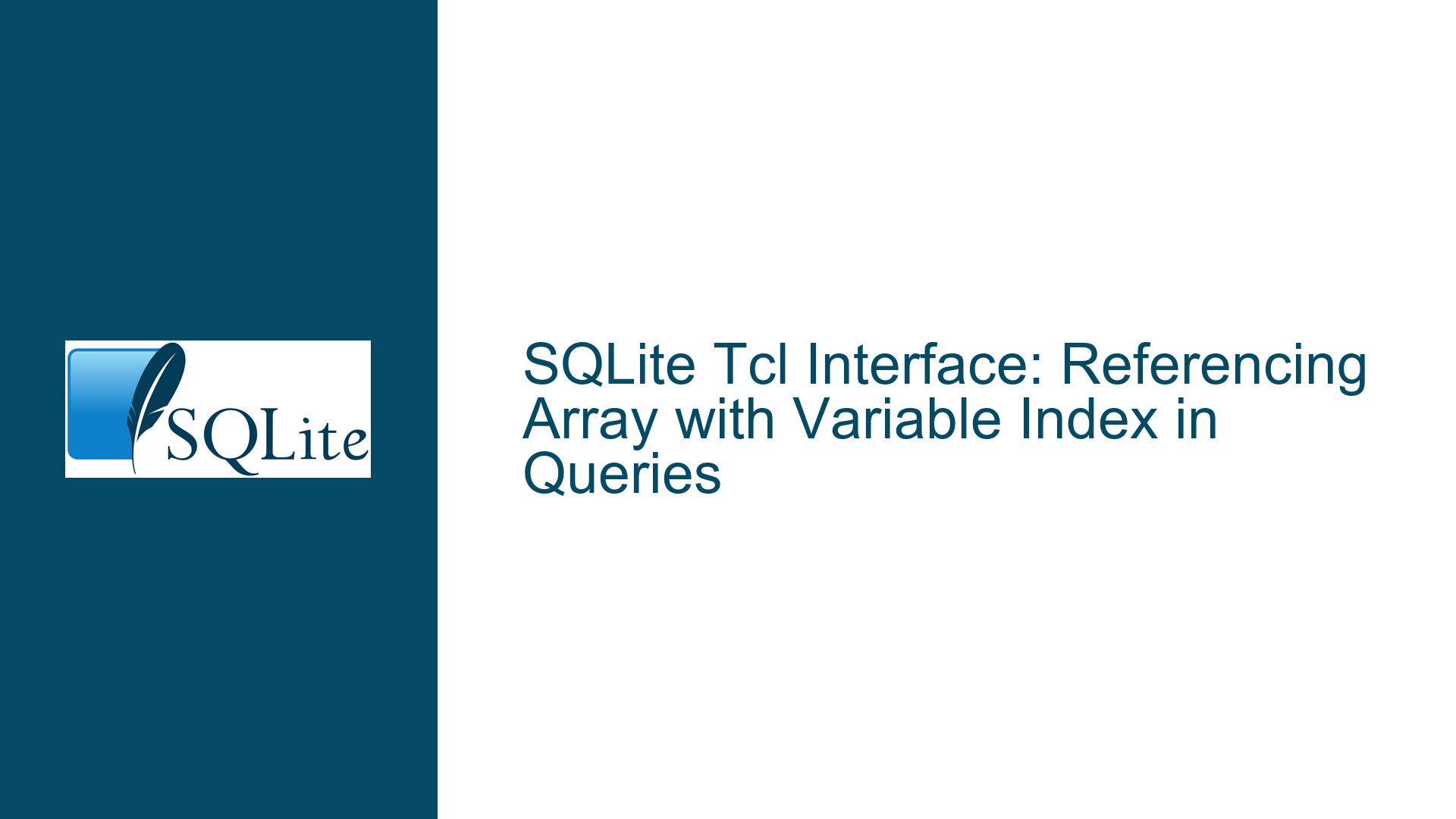SQLite Tcl Interface: Referencing Array with Variable Index in Queries
Issue Overview: Referencing Array Elements with Variable Indexes in SQLite Tcl Interface
The core issue revolves around the ability to reference array elements using variable indexes directly within SQLite queries executed through the Tcl interface. In Tcl, arrays are associative, meaning they are indexed by strings rather than integers. This associative nature allows for flexible data structures, but it introduces complexity when integrating with SQLite queries, especially when the array index is dynamic and stored in a variable.
Consider the following Tcl code snippet:
array set req {}
set req(usr1) {joe dokes}
set usr usr1
puts $req($usr)
=> joe dokes
db eval {select :req(usr1)}
=> {joe dokes}
Here, the array req is populated with a key-value pair, and the value is successfully retrieved using a direct reference to the array element within a SQLite query. However, the challenge arises when attempting to use a variable as the array index within the query:
db eval {select :req(:usr)}
The goal is to dynamically reference the array element using the variable usr as the index. This is a common requirement in scenarios where the array index is not known at compile time and must be determined at runtime.
The SQLite Tcl interface provides a mechanism to bind Tcl variables to SQLite query parameters using the : syntax. However, the interface does not natively support the direct use of variable indexes within array references in queries. This limitation necessitates a workaround to achieve the desired functionality.
Possible Causes: Limitations in SQLite Tcl Interface and Variable Binding
The inability to directly reference array elements with variable indexes in SQLite queries through the Tcl interface can be attributed to several factors:
Syntax Parsing Limitations: The SQLite Tcl interface parses the query string before executing it. During this parsing phase, the interface identifies and binds Tcl variables to SQLite parameters. However, the parsing mechanism does not support nested or complex expressions within the variable binding syntax. Specifically, it cannot interpret
:req(:usr)as a reference to an array element with a variable index.Variable Binding Mechanism: The
:syntax in the SQLite Tcl interface is designed to bind simple Tcl variables to SQLite parameters. When the interface encounters:req(usr1), it interpretsreq(usr1)as a single variable name and attempts to bind its value to the query parameter. However, when the index itself is a variable (:usr), the interface cannot resolve the nested reference, leading to a syntax error or unexpected behavior.Array Handling in Tcl: Tcl arrays are inherently different from SQLite’s data structures. While Tcl arrays are associative and can be indexed by strings, SQLite operates on tables with rows and columns. The SQLite Tcl interface must bridge this gap by converting Tcl data structures into a format that SQLite can understand. This conversion process does not inherently support the dynamic resolution of array indexes.
String Interpolation vs. Variable Binding: In Tcl, string interpolation allows for the direct substitution of variable values within double-quoted strings. This feature can be leveraged to construct query strings dynamically. However, the SQLite Tcl interface’s variable binding mechanism (
:variable) does not support interpolation, leading to the need for alternative approaches when dealing with dynamic array indexes.
Troubleshooting Steps, Solutions & Fixes: Dynamic Array Index Referencing in SQLite Tcl Queries
To address the issue of referencing array elements with variable indexes in SQLite queries through the Tcl interface, several approaches can be employed. Each approach has its own advantages and trade-offs, and the choice of method depends on the specific requirements of the application.
1. Preprocessing the Array Index Before Query Execution
One straightforward solution is to preprocess the array index before executing the query. This involves extracting the array element using the variable index and storing it in a separate variable, which can then be bound to the query parameter.
array set req {}
set req(usr1) {joe dokes}
set usr usr1
set user_value $req($usr)
db eval {select :user_value}
In this approach, the array element is accessed and stored in user_value before the query is executed. The query then references user_value directly, avoiding the need to resolve the array index dynamically within the query.
Advantages:
- Simple and easy to implement.
- Avoids the complexity of nested variable references in the query.
Disadvantages:
- Requires additional preprocessing steps.
- May not be suitable for scenarios where the array index changes frequently within a loop or iterative process.
2. Using String Interpolation to Construct the Query
Another approach is to use Tcl’s string interpolation feature to construct the query string dynamically. This involves embedding the array element directly into the query string using double quotes.
array set req {}
set req(usr1) {joe dokes}
set usr usr1
db eval "select '$req($usr)'"
In this method, the array element is interpolated into the query string before it is passed to the db eval command. The query string is constructed with the actual value of the array element, eliminating the need for variable binding within the query.
Advantages:
- Directly resolves the array element within the query string.
- No need for additional preprocessing steps.
Disadvantages:
- Potential security risks if the array element contains malicious SQL code (SQL injection).
- Less efficient for large datasets or complex queries due to repeated string construction.
3. Leveraging Tcl’s subst Command for Dynamic Query Construction
The subst command in Tcl can be used to perform variable substitution within a string. This command can be employed to dynamically construct the query string with the array element.
array set req {}
set req(usr1) {joe dokes}
set usr usr1
set query {select '$req($usr)'}
set query [subst $query]
db eval $query
Here, the subst command is used to replace $req($usr) with its actual value before the query is executed. This approach combines the benefits of string interpolation with the flexibility of dynamic query construction.
Advantages:
- Allows for more complex query construction with multiple variables.
- Reduces the risk of SQL injection compared to direct string interpolation.
Disadvantages:
- Slightly more complex than direct string interpolation.
- Requires careful handling of quotes and special characters in the query string.
4. Using Tcl Procedures to Encapsulate Query Logic
For more complex scenarios, encapsulating the query logic within a Tcl procedure can provide a cleaner and more maintainable solution. The procedure can handle the dynamic resolution of array indexes and construct the query accordingly.
proc get_user_data {db array_name index} {
upvar $array_name arr
set user_value $arr($index)
return [$db eval {select :user_value}]
}
array set req {}
set req(usr1) {joe dokes}
set usr usr1
get_user_data db req $usr
In this approach, the get_user_data procedure takes the database handle, array name, and index as arguments. It resolves the array element and executes the query, returning the result. This method abstracts the complexity of dynamic array indexing and provides a reusable solution.
Advantages:
- Encapsulates query logic, improving code maintainability.
- Reusable across different parts of the application.
Disadvantages:
- Requires additional code to define and manage procedures.
- May introduce overhead for simple queries.
5. Combining Variable Binding with String Interpolation
In some cases, a combination of variable binding and string interpolation can be used to achieve the desired functionality. This approach involves constructing part of the query string dynamically while using variable binding for other parts.
array set req {}
set req(usr1) {joe dokes}
set usr usr1
set query "select :req($usr)"
db eval $query
Here, the query string is constructed dynamically using string interpolation, but the array element is still referenced using the : syntax. This method leverages the strengths of both approaches, allowing for dynamic index resolution while maintaining the security benefits of variable binding.
Advantages:
- Balances flexibility and security.
- Reduces the risk of SQL injection compared to full string interpolation.
Disadvantages:
- Requires careful handling of query string construction.
- May not be suitable for all scenarios, especially those involving complex queries.
6. Utilizing Tcl’s dict Data Structure as an Alternative to Arrays
In some cases, replacing Tcl arrays with the dict data structure can simplify the handling of dynamic indexes. The dict structure provides a more flexible and efficient way to manage key-value pairs, and it can be easily integrated with SQLite queries.
set req [dict create usr1 {joe dokes}]
set usr usr1
set user_value [dict get $req $usr]
db eval {select :user_value}
In this approach, the dict structure is used to store the key-value pairs, and the dict get command is used to retrieve the value associated with the dynamic index. The retrieved value is then bound to the query parameter.
Advantages:
- Simplifies the handling of dynamic indexes.
- Provides better performance and flexibility compared to arrays.
Disadvantages:
- Requires refactoring existing code to use
dictinstead of arrays. - May not be suitable for all use cases, especially those requiring complex array operations.
7. Implementing Custom SQL Functions in SQLite
For advanced scenarios, custom SQL functions can be implemented in SQLite to handle dynamic array indexing. These functions can be written in Tcl or another supported language and registered with the SQLite database. The custom function can then be called within the query to resolve the array element.
proc get_array_element {array_name index} {
upvar $array_name arr
return $arr($index)
}
db function array_element get_array_element
array set req {}
set req(usr1) {joe dokes}
set usr usr1
db eval {select array_element('req', :usr)}
In this approach, the get_array_element procedure is defined to retrieve the array element using the provided index. The procedure is then registered as a custom SQL function using db function. The query can call this function to resolve the array element dynamically.
Advantages:
- Provides a powerful and flexible solution for complex scenarios.
- Encapsulates the logic within the database, improving code organization.
Disadvantages:
- Requires advanced knowledge of SQLite and Tcl.
- Introduces additional complexity and potential performance overhead.
8. Using Prepared Statements with Dynamic Index Resolution
Prepared statements can be used to optimize the execution of queries with dynamic array indexes. By preparing the statement once and binding the array element dynamically, the query can be executed efficiently.
array set req {}
set req(usr1) {joe dokes}
set usr usr1
set stmt [db prepare {select :user_value}]
set user_value $req($usr)
$stmt execute
In this method, the query is prepared once, and the array element is bound to the parameter before execution. This approach reduces the overhead of query parsing and optimization, making it suitable for scenarios where the query is executed multiple times with different array indexes.
Advantages:
- Improves performance for repeated query execution.
- Provides a clean and efficient way to handle dynamic array indexes.
Disadvantages:
- Requires additional code to manage prepared statements.
- May not be necessary for one-off queries or simple scenarios.
9. Exploring Alternative Database Interfaces
If the limitations of the SQLite Tcl interface prove to be too restrictive, exploring alternative database interfaces or libraries may be a viable solution. Other interfaces may provide better support for dynamic array indexing or offer additional features that simplify the integration of Tcl data structures with SQLite.
For example, using the tclsqlite extension or other third-party libraries may provide enhanced functionality or more flexible variable binding mechanisms. These alternatives should be evaluated based on the specific requirements of the application and the trade-offs involved.
Advantages:
- Potential access to more advanced features and better performance.
- May provide a more suitable solution for complex use cases.
Disadvantages:
- Requires learning and integrating new libraries or interfaces.
- May introduce compatibility issues or additional dependencies.
10. Best Practices and Recommendations
When dealing with dynamic array indexes in SQLite queries through the Tcl interface, the following best practices and recommendations should be considered:
Preprocessing Array Indexes: Whenever possible, preprocess array indexes before executing the query. This approach simplifies the query and avoids the complexity of dynamic index resolution.
Use String Interpolation with Caution: While string interpolation can be a quick solution, it should be used with caution to avoid SQL injection risks. Always sanitize and validate input data when using interpolation.
Encapsulate Query Logic: Encapsulating query logic within Tcl procedures or custom SQL functions can improve code maintainability and reusability. This approach also abstracts the complexity of dynamic array indexing.
Consider Alternative Data Structures: In some cases, replacing Tcl arrays with
dictstructures or other data types can simplify the handling of dynamic indexes and improve performance.Optimize Query Execution: For repeated query execution, consider using prepared statements or other optimization techniques to reduce overhead and improve performance.
Evaluate Alternative Interfaces: If the SQLite Tcl interface’s limitations are too restrictive, evaluate alternative interfaces or libraries that may provide better support for dynamic array indexing.
By following these best practices and selecting the appropriate approach based on the specific requirements of the application, the issue of referencing array elements with variable indexes in SQLite queries through the Tcl interface can be effectively addressed.






